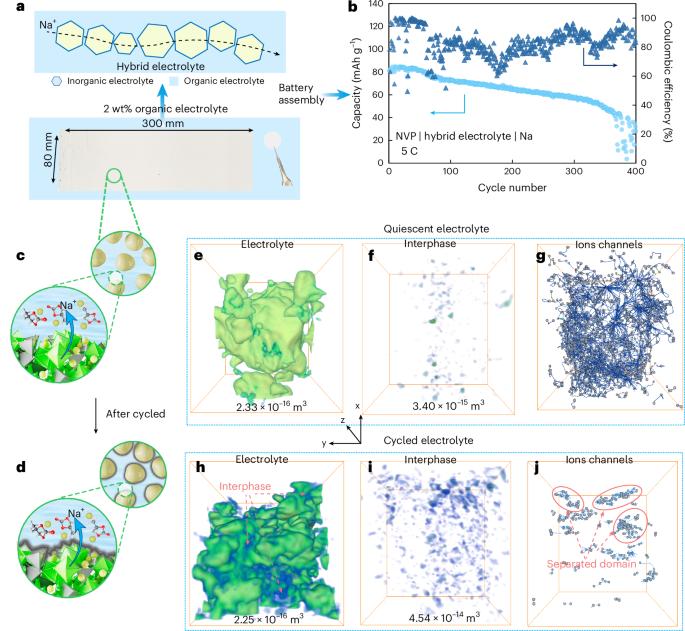Hybrid electrolyte enables solid-state sodium batteries sustaining 50,000 cycles
IF 27.1
1区 环境科学与生态学
Q1 ENVIRONMENTAL SCIENCES
引用次数: 0
Abstract
Solid-state sodium (Na) batteries open the opportunity for more sustainable energy storage due to their safety, low cost and high energy density. Inorganic solid electrolytes show notable advantages for such technologies but suffer from poor interfacial compatibility, rendering hybrid solid–liquid electrolytes an alternative. Here we show that the interfacial failure in the hybrid electrolyte system (Na3Zr2Si2PO12 (NZSP) and 1 M NaClO4 in propylene carbonate/ethylene carbonate/fluoroethylene carbonate) is closely associated with Na vacancies on the surface of NZSP. Asymmetric kinetics of solid and liquid electrolytes lead to the formation of Na vacancies and an unstable environment in the Helmholtz layer, while the organic molecules (propylene carbonate) are energetically favourable towards undesirable dehydrogenation. To eliminate the Na vacancies layer, we designed an ion-anchoring interlayer that serves to minimize the interfacial polarization. The unique O–Na coordination between the interfacial layer and NSZP confers stability to the solid–liquid interface. As demonstrated, the sodium battery with the modified hybrid electrolyte sustains 50,000 cycles with capacity retention of 86.3%. Our work provides a new path for the design of solid-state Na batteries, highlighting their potential for widespread practical applications. Solid-state sodium batteries represent more sustainable options as they combine resource abundance with safety. This work advances their performance, particularly fast cycling lifespan, to an unprecedented level utilizing a hybrid electrolyte.

混合电解质可使固态钠电池维持5万次循环
固态钠(Na)电池由于其安全、低成本和高能量密度,为更可持续的能量存储提供了机会。无机固体电解质在此类技术中表现出显著的优势,但其界面兼容性较差,使得混合固液电解质成为一种替代方案。研究表明,Na3Zr2Si2PO12 (NZSP)和1 M NaClO4(碳酸丙烯酯/碳酸乙烯/氟乙烯碳酸酯)混合电解质体系的界面破坏与NZSP表面的Na空位密切相关。固体和液体电解质的不对称动力学导致在亥姆霍兹层中形成Na空位和不稳定的环境,而有机分子(碳酸丙烯酯)在能量上有利于不期望的脱氢。为了消除Na空位层,我们设计了一个离子锚定间层,以减少界面极化。界面层和NSZP之间独特的O-Na配位赋予了固液界面的稳定性。结果表明,采用改性的混合电解液制备的钠电池可维持5万次循环,容量保持率为86.3%。我们的工作为固态钠电池的设计提供了一条新的途径,突出了其广泛实际应用的潜力。固态钠电池代表了更可持续的选择,因为它们结合了资源丰富和安全性。这项工作提高了它们的性能,特别是快速循环寿命,利用混合电解质达到了前所未有的水平。
本文章由计算机程序翻译,如有差异,请以英文原文为准。
求助全文
约1分钟内获得全文
求助全文
来源期刊

Nature Sustainability
Energy-Renewable Energy, Sustainability and the Environment
CiteScore
41.90
自引率
1.10%
发文量
159
期刊介绍:
Nature Sustainability aims to facilitate cross-disciplinary dialogues and bring together research fields that contribute to understanding how we organize our lives in a finite world and the impacts of our actions.
Nature Sustainability will not only publish fundamental research but also significant investigations into policies and solutions for ensuring human well-being now and in the future.Its ultimate goal is to address the greatest challenges of our time.
 求助内容:
求助内容: 应助结果提醒方式:
应助结果提醒方式:


